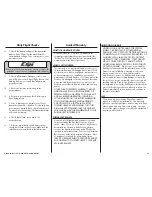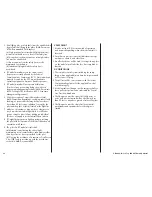
22
E-flite Hawker Sea Fury 480 ARF Assembly Manual
preflight
Check your Radio
Before going to the field, make sure your batteries
are fully charged per the instructions included with
your radio. Charge the transmitter and motor battery
for your airplane. Use the recommended charger
supplied with your particular radio system, following
the instructions provided with the radio. In most
cases, the radio should be charged the night before
going out flying.
Before each flying session, be sure to range check your
radio. See your radio manual for the recommended
range and instructions for your radio system. Each
radio manufacturer specifies different procedures for
their radio systems. Next, run the motor. With the
model securely anchored, check the range again. The
range test should not be significantly affected. If it
is, do not attempt to fly! Have your radio equipment
checked out by the manufacturer.
Double-check that all controls (aileron, elevator, rudder
and throttle) move in the correct direction.
Check the radio installation and make sure all the
control surfaces are moving correctly (i.e., the correct
direction and with the recommended throws).
Check all the control horns, servo horns, and clevises
to make sure they are secure and in good condition.
Range Test your Radio
Before each flying session, and especially with a new
model, it is important to perform a range check. It
is helpful to have another person available to assist
during the range check. If you are using a Spektrum
™
transmitter, please refer to your transmitter’s manual for
detailed instructions on the range check process.
1. With the model resting on the ground, stand 30
paces (approximately 90 feet) away from the model.
2. Face the model with the transmitter in your
normal flying position. Be sure the throttle is in the
full down position and plug the flight battery into
the speed control.
3. As you move the controls, watch to be sure the
airplane’s motor and controls operate smoothly.
You should have total control of the model at 30
paces (90 feet).
4. If control issues exist, call the appropriate
Horizon Product Support office (see addresses
listed in the Warranty Services section of this
manual) or go to
horizonhobby.com
to find a local
Spektrum distributor in your country for service
when using a Spektrum radio system.
Flying your Model
Begin by placing the model on the ground. Check all
control throws and ensure everything is traveling in the
right direction. Move your idle trim up until the prop
begins to spin; this will be your flight idle. Taxi into
position on the runway, facing into the wind. Apply
power slowly and steer with rudder. The tail will come
up very quickly. As you apply full throttle and come
to speed, apply a slight amount of up elevator and
the Sea Fury should lift off gently and begin to climb
upwards. As you climb out, release the elevator and
maintain a gentle climb to about 100 feet of altitude.
Once at about 100 feet of altitude, trim the model for
level flight at 5/8 throttle. You will find the Sea Fury to
be very gentle on the control and feel quite light on the
sticks. The model is capable of all the basic aerobatic
maneuvers; loops, rolls, stall turns, inverted flight, etc.
If you have no roll issues with the model, then you are
ready to set up for landing. We normally do a pass
over the runway first. Turn into the downwind leg and
manage the power at about 1/2 throttle. As you turn
to base leg, you may reduce the throttle a bit and
then, when you turn onto final approach, adjust the
power to maintain a shallow descent with the model.
As you come down to an altitude of about 8 feet over
the runway, begin to level the model out, and, as you
get within 3 feet, you will begin to flare for landing.
The Sea Fury likes to be either landed on the mains or
three pointed on the gear in a full stall. The choice is
yours.
We at E-flite hope you enjoy your Sea Fury as much
as we have. Happy landings!







































